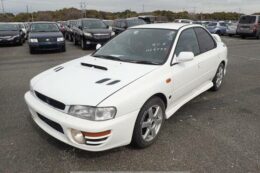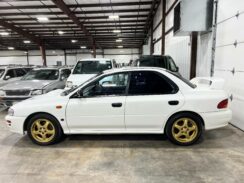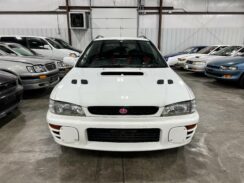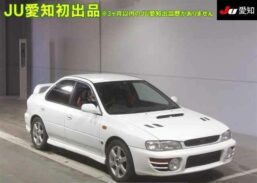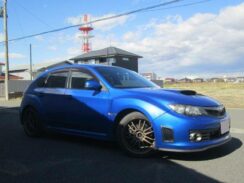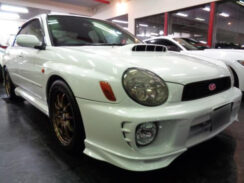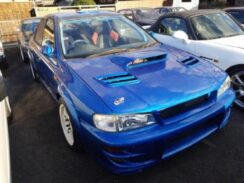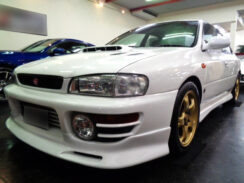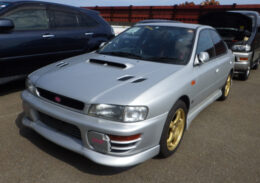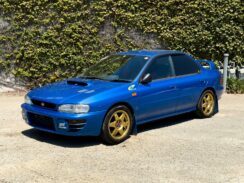Subaru Impreza WRX STI
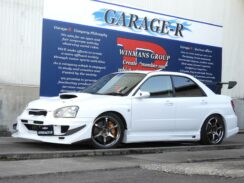
Subaru Impreza WRX STI
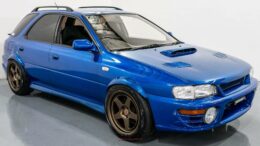
1994 Subaru Impreza WRX STi Wagon (WA)
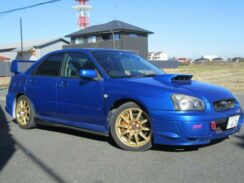
2003 Subaru Impreza WRX STi (GDB Blobeye)
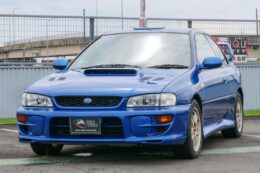
Subaru Impreza WRX STi Coupe (N.8490)
Subaru Impreza Buying Guide
If you are looking for a high-quality vehicle that offers excellent durability, safety, and reliability, then you should probably consider buying the Subaru Impreza. The Impreza is a compact car that has been manufactured by Subaru since 1992 and is now in its fifth generation. This legendary Japanese model was introduced to replace the Leone, and this saw the EA series engines replaced with the EJ series. Since its launch, the Impreza has been available in both a four-door sedan and five-door hatchback configuration.
Subaru Impreza Pros and Cons
Pros
Highly Tunable
Naysayers will tell you that buying a Subaru Impreza WRX STi, or any other Subaru for that matter, is one of the worst financial decisions you can make (and that they can only make 300 horsepower). Boxer engine issues aside, EJ engines are some of the most tunable boxer engines, but only with the proper mods – and under the hands of a good tuner. Newbies think throwing on a massive turbocharger and an aftermarket exhaust gives them the capability to drive around recklessly, recreating scenes from Baby Driver.
Why are boxer engines highly tunable, you may ask? Pistons have a larger diameter than the stroke, reducing shaking forces and making power delivery easy throughout the RPM range. However, installing mods and tuning boxer engines isn’t a walk in the park. Most tuners will recommend rebuilding the engine with better aftermarket peripherals and forged internals for maximum reliability and durability. This solves issues such as oil starvation and turbo failure, which are some of the biggest problems in boxer engines.
A fully rebuilt boxer engine will easily push anything over 500 horsepower, with the 2.5-liter EJ255 and EJ257 being more capable than the 2.0-liter EJ205 and other turbocharged 2.0-liter variants. An interview with renowned Subaru tuners, Yimi Sports, reveals the tuning capabilities, weaknesses, and strengths of Subaru Boxer engines.
Versatile and Practical
Where’s the fun of having a tuner car if you can’t enjoy it with your friends or family? Buying a Subaru Impreza WRX STi guarantees memories of driving your children to school early in the morning and drifting in the snow with your friends in the rear seat. And when you pick up your kids from school, they’ll be proud knowing that their parent has the coolest car in school. Mall runs don’t have to be boring, like driving a minivan. Groceries and everything else will fit perfectly in the trunk, especially if it’s an Impreza hatch.
During the winter, you don’t have to keep your Impreza in hibernation, unlike most JDM car owners who park their cars and drive alternate daily driver cars. Some winter wheels and tires are all you need to tackle the snow, and you don’t have to clear snow off the driveway when leaving for work. Adding a lift kit wouldn’t hurt the car. After all, they do it at the WRC, and aftermarket lift kits are easy to get.
A True Driver-Focused Car
Subaru designed the Impreza WRX STi with only one focus: the driver’s experience. Few buyers think twice about buying one once they test drive the car. Step into the car and feel the MOMO steering wheel and sitting position, and you’ll realize why it’s impossible not to hate the car regardless of its possible future problems. Once you get moving, the firm clutch, short shifts between gears, and the rumbling exhaust will make you feel like Colin McCrae racing at the Tour de Corse.
Throttle response is timed perfectly even in older Imprezas without any mods, provided the engine is healthy. Thanks to Subaru’s symmetrical all-wheel-drive system, rally-tuned suspension, and lightweight chassis, among other features, handling is also perfect in the Impreza. You don’t have to cage the car through corners, regardless of the driving surface. Expecting less from a rally-bred vehicle would be considered a crime in the car community if there were laws on what to expect from old JDM cars.
Cheaper Than a Mitsubishi EVO
The Mitsubishi EVO is the Mitsubishi equivalent of the Impreza WRX STi. Both are iconic JDM tuner sedans, and nothing comes close if you’d prefer a light and thrilling to drive JDM sedan. Not even the gentleman’s supra, the Toyota Altezza. The rivalry between the Subaru Impreza WRX STi and the Mitsubishi EVO will never end, but the Impreza beats the EVO regarding availability and purchasing costs.
If you’re in the market for either, you’ll notice an Impreza costs half as much as an EVO from the same year, with prices starting at roughly $6,000, and it’s easier to find the perfect Impreza. Rarely do Mitsubishi EVOs sell for less than $10,000, regardless of the generation. In addition, the Impreza is available either as a hatchback or sedan, while the EVO is only available as a sedan. Only the EVO IX is available, but good luck finding one that isn’t overpriced.
Big Aftermarket Support and Community
One of the reasons JDM cars, including the Subaru Impreza, are frequently bought despite their old age is aftermarket support which makes ownership easy since most manufacturers don’t make parts for their older cars. The Subaru Impreza is one of the most common JDM cars, and aftermarket manufacturers make all types of parts for it, from engine upgrade parts to body kits and wheels. Custom parts are also easy to get, especially from tuner shops that specify in Subarus.
Nothing makes car ownership easier than having support from owners’ communities and forums. Navigating around common problems becomes easier even for first-time Impreza owners. There will always be a discussion to follow, an online article to refer to or a YouTube video of an easy fix, tuning guide, or general information.
Cons
EJ Engines make Imprezas High-Maintenance Cars
Buying a Subaru Impreza might not cost much, but maintenance is on another level, mainly due to engine oil-related issues. It’s not the type of car you’d want to buy as a beginner or for a teenager’s 16th birthday. Not that ownership will take you to the scrap yard to dump the car, but owning an Impreza requires some experience with cars. Maintenance costs can deem the car undrivable for months since boxer engines are not the easiest engine to work on.
Something as easy as a head gasket change on a typical four-cylinder engine could dent you north of $1,500 since it’s impossible to do it on a boxer engine with the engine in the car. Choosing the power increment path is also costly, primarily due to the inevitable costs of rebuilding the engine.
Cheap Plastic Interior Trims
The Subaru Impreza wasn’t designed with any creature comforts except air conditioning. The seats get uncomfortable with longer distances, and there are no cupholders to put your mug of coffee, which is necessary during winter. Rattling plastic interior trims become a nuisance when driving over bumps or on a gravel road, and the interior door handles work occasionally. But such issues are expected in old JDM cars, and you either have to get used to it or get the interior retrimmed.
Subaru Impreza WRX STi Common Issues
Oil Starvation and Ringland Failure
This is a common problem in all boxer engines caused by piston ring failure, which are the compression and oil control rings. The oil control rings wear out rapidly. Thus, they can’t scrap oil from the cylinder walls leaving it in the combustion chamber where it gets burned along with fuel and air. When this happens, you’ll notice excessive smoking from the exhaust, and the engine will also overheat due to oil starvation. Oil starvation in boxer engines is worse since the oil can drip down due to the horizontal engine placement.
Ringland failure is among the most feared issues in Subaru engines, and it also causes compression oil control rings problems, especially in Subaru with the OEM pistons. The rings sit inside the ringlands, which crack or cave in over time due to high engine temps and pressure. This displaces the rings, causing hot combustion gases to leak through the piston heads into the oil sump, heating the oil and affecting circulation.
Early signs of ringland failure include loss of power, misfiring, and smoke from the oil cap. If not fixed, the ringland and piston shavings end up being ground against the cylinder wall, thus damaging it. This causes piston slap where the pistons knock against the cylinder walls, especially during startup, idling, and low RPMs. Piston slap is also caused by wearing out of the Teflon coating on the pistons due to high engine temps and made worse by oil starvation.
Using high-quality synthetic oil, constantly checking oil levels, and refilling at the slightest gauge drop will only be a saving grace for a while. Most owners and Subaru mechanics recommend a complete engine rebuild, and you’ll have to go the aftermarket which will dent your pockets. But if you love your Subaru, a permanent fix is worth it regardless of the money spent.
Head Gasket Failure
Head gasket issues in Subaru are more of a disadvantage than a problem. It starts with the OEM head gasket made of single-layer steel and graphite that chips, strips, and peeks quicker than a double-layer head gasket. Head gasket failure results in engine oil and coolant contamination (internal leak), causing the engine to overheat and putting it at risk of blowing. When draining the engine oil or coolant, if there’s a white sludge in either, it’s time for a head gasket replacement. But ensure you flush the oil and coolant system before that.
External head gasket coolant might also be an issue, especially in high mileage Subarus, where coolant leaks out of the engine, dripping down the head and block. You’ll also notice oil patches on the ground, excessive white smoke from the exhaust, and mainly overheating if the head gasket is too far gone. With internal and external head gasket leaks being a possibility in Subarus made before 2012, including the Impreza WRX STi, replacing the head gasket with a high-quality aftermarket multi-layer gasket is the best solution.
What can you do to prevent head gasket failure in a Subaru Impreza? For starters, improving cooling by regularly changing coolant fluid and checking for leaks in the coolant system ensures the head doesn’t warp, preventing head gasket failure. It’s also recommended to change the head gasket at 100,000-mile intervals in any Subaru Impreza with a turbocharged engine. Still, it might last less than 100,000 miles, depending on the driving conditions and power output. For example, highly tuned Imprezas run hotter; the same for cars driven in high temperatures.
Turbocharger Issues
One of the parts most tuners will recommend changing when tuning a Subaru WRX STi is the turbocharger, known to fail even without any mods installed. Part of the reason why the turbocharger fails is due to Subaru’s oil issues which include oil starvation and head gasket failure. If oil isn’t well-circulated in the engine, it won’t get to the turbocharger oil supply line, causing the bearings to overheat due to excess friction, and the turbo might blow. Early signs of turbo failure include a loud whining sound, sluggish throttle response, and incorrect boost readings.
Fixing the oil starvation issue is one of the steps to get the turbo spooling like new again. Previous internal engine damage could also cause turbo failure if metal shavings end up in the turbocharger. This doesn’t happen often, but it’s one of the reasons you should keep up on oil and coolant changes which reduce friction and overheating in the engine.
Another issue causing turbocharger failure in turbocharged EJ engines, especially the 2.5-liter EJ255, is the banjo bolt (bolt with a hole on the threads) in the turbocharger oil supply line. It has a small mesh in the hole meant for filtering the oil going to the turbocharger, which gets clogged by debris that passes through the engine oil filter, thus causing turbocharger oil starvation. Upgrading the engine oil filter to improve filtration and cleaning the banjo bolt improves oil flow to the turbocharger.
Rod Bearing Failure
Rod bearings have always been a major weakness in Subaru engines, with owners complaining of the same in the new FA and FB series engines that preceded the EJ series engines. And just like turbocharger failure, rod bearing failure is caused by oil starvation. Funny how oil issues are the root cause of every major problem in the Subaru Impreza WRX STi. The only early signs of road bearing failure are loss of oil pressure and metal shavings in the engine oil, but these could mean several things.
Most owners will tell you that it happens suddenly when you hear a loud knocking sound from the engine as the rods knock against the cylinder walls. Once the rod bearings go out, the only solution to get your beloved money pit, should you decide to buy one, back onto the road is buying a new engine or fully rebuilding the engine. But if it still has some life, ensure all oil issues are taken care of, including flushing the oil circulation system and replacing the oil lines, oil pump, and oil filter.
Cooling System Issues
Subarus don’t generally have cooling system issues, but one or two things may be failing or bound to fail. For starters, boxer engines run hot, so the coolant lines will become brittle and crack, thus leaking coolant. The thermostat is another victim of damage due to high engine temps, and it might not open to let coolant flow to the radiator. Also, contaminated coolant caused by an internally leaking head gasket will not cool the engine efficiently, and the oil starvation worsens it.
A damaged intercooler also causes the engine to overheat since it doesn’t cool air being fed to the engine from the hot turbocharger. Overhauling the cooling system and using high-quality coolant easily fix cooling issues. Doing it with aftermarket parts, such as a bigger radiator and intercooler, is better than going OEM. If overheating is a minor issue, burping the cooling system helps eliminate it.
What To Look For When Buying a Subaru Impreza
Like when buying any other car, you need to check for issues. Such problems don’t necessarily have to be major, as they are easily detectable, but rather minor ones that turn major in the long run. Rust is inevitable in most JDM cars as they were not manufactured with a rust-protective coating, and the Subaru Impreza is no exception. Common rust spots include the steel fenders, quarter panels, strut towers, underneath the wheel arches, and on the chassis.
While checking for rust on the chassis, check the condition of the suspension bushings. They shouldn’t be too stiff and faded or cracked. Most owners never replace the suspension bushings, not only in Subaru Imprezas but also in other cars. Also, inspect the exhaust for leaks from underneath the vehicle and the exhaust manifold in the engine bay. This must be done with the engine running. Boxer engines rumble deeply, so the only way to detect exhaust leaks is if there are hissing sounds.
Some sellers are honest enough to list all mods done on the car, which helps buyers determine whether it’s worth buying since boxer engines are sensitive to mods and tunes. It might be a solid deal if the mods are worth it, and the price is not inflated based on them. Beginners are advised not to buy heavily tuned Imprezas, especially those with unreliable mods. You might regret buying an Impreza and loathe it for the rest of your life if you buy a lemon.
Thoroughly inspect the engine bay for leaks, which should be done after test-driving the car for a while. Don’t feather it too much, but don’t go too hard on it either. Keep it subtle. During the test drive, listen for differential noises, especially on high mileage and rough-looking Imprezas. Check the differentials for leaks after the test drive. Lastly, all documentation, including the title and import papers, if the car is imported, should be produced before closing the sale.
Average Prices
Subaru Impreza prices vary widely between the base model, WRX model, and the STi model but overall these are high-value-for-money vehicles.
Comparable Alternatives
- Mitsubishi Lancer Evolution (Buying Guide)
- Toyota Altezza (Buying Guide)
- Honda Civic (Buying Guide)
- Nissan Silvia (Buying Guide)
- Honda Integra (Buying Guide)
- Honda S2000 (Buying Guide)
Models and Specifications
1992-2001 Subaru Impreza First Generation
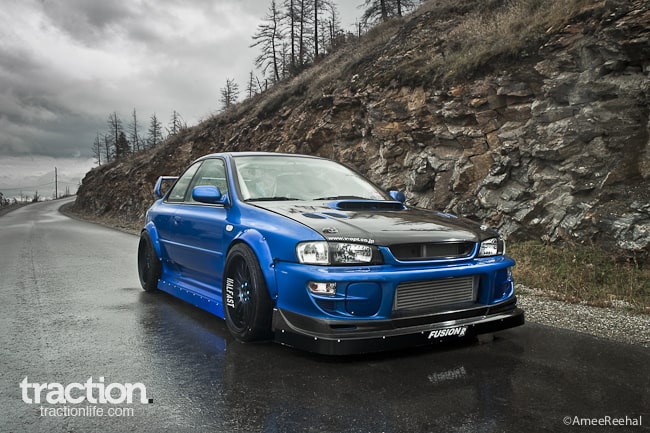
This first generation of the Impreza vehicles was offered in either front-wheel drive or all-wheel drive and in a four-door sedan or a five-door hatchback. It had a 1.8-litre, four-cylinder engine. Like many Subaru-built cars, the Impreza was equipped with a flat engine. The initial Subaru Impreza engine choices included the 1,6L, 1.8L, and 2.0L engines.
The Outback Sport was introduced to North America in 1994, and in 1995, the “L” sports wagon, which was an updated version of Impreza with a slightly lifted suspension and similar mechanical and performance functions, was introduced. For the first time in 1995, Subaru introduced a more powerful 2.2 L engine option, and in 1997, a 2.5-litre engine was introduced in the WRX model, and the 1.8-L model dropped the following year. The WRX STI. 2.5RS models became available in sedan form in 2000.
Specifications
| Production | 1992-2000 |
| Body type | 2-door coupe, 4-door sedan, 5-door hatchback |
| Engine | 1.5L EJ15F4 1.6L EJ16F4 1.8L EJ18F4 1.8L EJ18F4 (T/C) 2.0L EJ20F4 2.0L EJ20 F4 (T/C) 2.2L EJ22 F4 2.5L EJ25 F4 |
| Transmission | 5-Speed Manual 4-Speed Automatic |
| Length | 4,340 mm (170.9 in) |
| Width | 1690 mm (66.5In) |
| Height | 1405 mm (55.3 in) |
| Weight | 1220 kg |
2000-2007 Subaru Impreza Second Generation
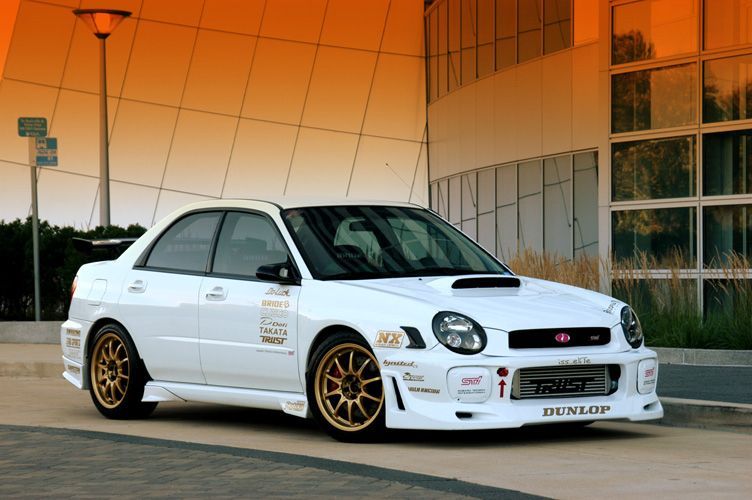
The “New Age’ Impreza was introduced in Japan in August 2000. Its size was larger than the previous one. The width size of the sedan increased by 40 mm (1.6 in) while that of the wagon increased by 5 mm (0.2 in). The coupe body in the first generation did not reappear in the second generation.
The STI models in this generation featured more powerful turbocharged engines of 2.0- L and 2.5- L outside Japan. The WRX model featured the 2.0-L turbocharged engine until 2005 when it adopted the 2.5-L turbocharged engine.
Specifications
| Production | 2000-2007 |
| Body type | 4-Door Sedan 5-Door Hatchback |
| Engine | 1.5L EJ15 H4 1.6L EJ16 H4 2.0L EJ20 H4 2.0L EJ20 H4-T 2.5L EJ25 H4 2.5L EJ25 H4-T |
| Transmission | 4-Speed Automatic 5-Speed Manual 6-Speed Manual (TY856WH3MA/TY856WH4MA/TY856WW6MA) |
| Length | 4,415 mm (173.8 in) |
| Width | Sedan: 1,730 mm (68.1 in) Wagon: 1,695 mm (66.7 in) |
| Height | 1,425 mm (56.1 in) |
| Weight | 1,360 kg (2,998.3 lb) |
| Wheelbase | 2,525 mm (99.4 in) |
2007-2014 Subaru Impreza Third Generation
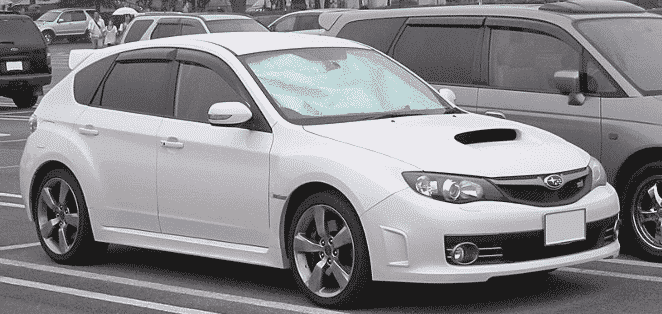
Subaru unveiled this third generation of Subaru Impreza on April 2, 2007 at a New York Auto Show. The unveiled models comprised the naturally aspirated Impreza and the turbocharged WRX versions. Initially, this new Impreza was offered as a five-door hatchback, but the unveiling saw these generations being discontinued.
In this series, the Impreza was designed as slightly longer, wider and with a longer wheelbase. With the third generation, two traditions were stopped; it saw the removal of the parking light switch atop the steering column and the introduction of window frames to improve harshness, noise, and vibration.
Specifications
| Name | Pre-Facelift Subaru Impreza Sedan |
| Production | 2007–2011 2007–2014 (WRX) |
| Body type | 4-Door Sedan (Narrow, GE) 4-Door Sedan (Wide, GV) 5-Door Hatchback (Narrow, GH) 5-Door Hatchback (Wide, GR) |
| Engine | 1.5L EL15 H4 (Gasoline) 2.0L EJ20 H4 (Gasoline) 2.0L EJ20 H4-T (Gasoline) 2.0L EE20 H4-T (Diesel) 2.5L EJ25 H4 (Gasoline) 2.5L EJ25 H4-T (Gasoline) |
| Transmission | 4-Speed Automatic 5-Speed Automatic 5-Speed Manual 6-Speed Manual (TY856UB1KA) |
| Length | 2 Sedan: 4,580 mm (180.3 in) Hatchback: 4,415 mm (173.8 in,620 mm (103.1 in) |
| Width | 1,740 mm (68.5 in) |
| Height | 1,475 mm (58.1 in) |
| Weight | 1,394 kg (3,073 lb) |
| Wheelbase | 2,620 mm (103.1 in) |
2011-2016 Subaru Impreza Fourth Generation
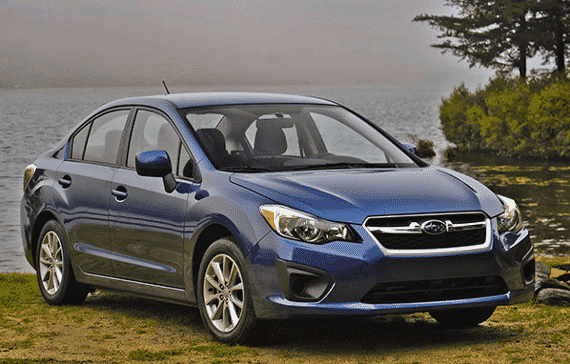
This generation of Subaru Impreza was unveiled in 2011 but was sold later in 2011 as a 2012 model year vehicle. Though it remained nearly the same size as the previous model, this new model was lighter, more efficient, and had better packages than the previous one. It had a longer wheelbase, thus providing more interior room for passengers. It had an impressive rear head and legroom, thus providing more comfort.
One of the most notable technologies incorporated into this generation is EyeSight technology. It’s a technology that uses human-like stereoscopic vision to judge distances and give warning to the driver, thus helping maintain safe distances while on highways.
Specifications
| Name | Subaru XV Subaru XV Crosstrek (2013-2015) Subaru Crosstrek Subaru WRX |
| Production | 2011–2016 2012–2017 (XV) 2014–Present (WRX) |
| Model years | 2012–2016 2012–2017 (XV) 2013–2017 (XV Crosstrek) 2015–Present (WRX) |
| Body type | 4-Door Sedan (GJ) 5-Door Hatchback (GP) 4-Door Sedan (VA) |
| Engine | 1.6L FB16 H4 (Gasoline) 2.0L FB20 H4 (Gasoline) 2.0L EE20 H4-T (Diesel) 2.0L FA20F H4-T (Gasoline) 2.5L EJ257 H4-T (Gasoline) 2.0L EJ207 H4-T (Gasoline) |
| Transmission | 5-Speed Manual 6-Speed Manual CVT Automatic |
| Length | Sedan: 4,580 mm (180.3 in) Hatchback: 4,414 mm (173.8 in) XV: 4,450 mm (175.2 in) WRX: 4,595 mm (180.9 in) |
| Width | 1,740 mm (68.5 in) XV: 1,750 mm (68.9 in) WRX: 1,795 mm (70.7 in) |
| Height | 1,465 mm (57.7 in) XV: 1,570 mm (61.8 in) WRX: 1,475 mm (58.1 in) |
| Weight | 1,320 kg (2,910 lb) |
| Wheelbase | 2,644 mm (104.1 in) XV: 2,635 mm (103.7 in) WRX: 2,650 mm (104.3 in) |
2016-Present Subaru Impreza Fifth Generation
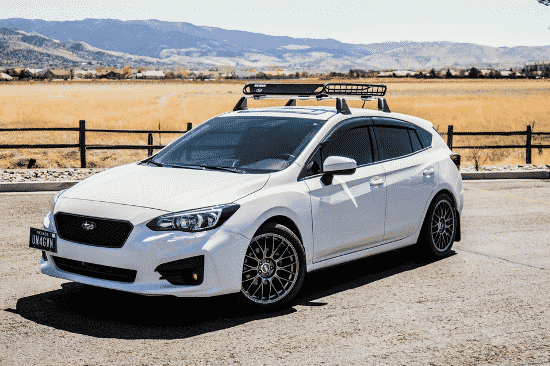
This new generation of Subaru Impreza, consisting of Impreza Sedan and hatchback, was unveiled in 2016. The new Impreza is powered by a revised version of the FB2.0 liter direct-injection boxer. This new engine was meant to improve acceleration and flexibility in power delivery. However, reviewers feel that this model tends to fall short of other competitors in the feature of acceleration power.
The Subaru EyeSight safety feature is still available in this generation, and Apple CarPlay and Android Auto have been incorporated. It’s the first Japanese vehicle to ever include a pedestrian airbag in its design. The car is regarded as among the safest cars and scored a high safety score in the Japan New Car Assessment Program.
Specifications
| Name | Subaru XV Subaru Crosstrek |
| Production | 2016–Present 2017-Present (XV) |
| Model Year | 2017–Present 2018-Present (XV) |
| Body type | 4-door Sedan (GK) 5-door Hatchback (GT) |
| Engine | 1.6L FB16 H4 (gasoline) 2.0L DAVCS FB20D H4 (gasoline) 2.0L FB20D e-Boxer Hybrid H4 |
| Transmission | 5-Speed Manual 6-Speed Manual (XV) CVT Automatic |
| Length | Sedan: 4,625 mm (182.1 in) Hatchback: 4,460 mm (175.6 in) XV: 4,465 mm (175.8 in) |
| Width | 1,775 mm (69.9 in) XV: 1,800 mm (70.9 in) |
| Height | Sedan: 1,455 mm (57.3 in) Hatchback: 1,480 mm (58.3 in) XV: 1,615 mm (63.6 in) |
| Weight | 1,386–1,433 kg (3,056–3,159 lb) |
| Wheelbase | 2,670 mm (105.1 in) |
FAQ
If you are looking to buy a Subaru Impreza, you should go for the WRX or WRX STI, the highest spec Imprezas you can buy. With prices starting at around $10,000, a Subaru Impreza WRX or WRX STI is among the best sports cars you can buy.
A Subaru Impreza will last for 200,000 to 250,000 miles before you start replacing the major engine, suspension and drivetrain components. But this is only possible if you maintain your Impreza regularly, especially the EJ engines, which develop a ton of issues if not appropriately maintained.
You can easily fit 16-inch wheels on a Subaru Impreza without cutting or rolling the fenders. 17-inch wheels are manageable but will run against the fenders when cornering hard.
A Subaru Impreza will last 13 to 17 years from the time of production before you’ll need to replace the major engine, suspension and drivetrain components. This translates to 200,000 to 250,000 miles of driving.
At the production time, the base-spec models with naturally aspirated EJ engines made 100 to 150 horsepower. The WRX and WRX STI made over 200 horsepower from the turbocharged EJ engines.
The Subaru Impreza wasn’t built with any towing capabilities. Still, you can tow between 1500 and 2500 pounds depending on the year of manufacture. Older models have a lower maximum towing capacity than later models.
2007-2011 Subaru Impreza. The 2007-2011 Subaru Impreza had the most recalls due to engine issues and has the lowest Impreza reliability rating at 1/5.
Any Pre-2000 Subaru Impreza has a 13.2-gallon fuel tank, and after 2000, the fuel tank size was increased to 15.9 gallons until 2008. Subaru Imprezas made between 2008 and 2012 have a 16.9-gallon fuel tank which was later reduced to 14.5 gallons after 2012 and 13.3 gallons after 2017.
All Subaru Impreza Generations were produced and assembled in Japan except the second-gen Impreza, assembled in the US from 2001 to 2007.
The Subaru Impreza is a compact Sedan produced by Subaru from 1992 to date with various models, including the Impreza WRX and WRX STI, which are performance spec models of the Impreza used in different motorsports including the WRC.
2007-2007. Apart from great looks, the GD/GG Subaru Impreza is considered one of the most reliable compact sedans. The WRX and WRX STI engines can push 400 horsepower with stock engine internals if you want a little extra power.
Most Subaru owners and experts will tell you not put any engine except a Subaru engine in an Impreza, which is true. The engine bay of the Subaru Impreza was designed to fit a boxer engine only, and fitting any other motor can be a pain. However, engine swaps on Imprezas have been done before, and nothing should stop you from trying.
Sources
- https://en.wikipedia.org/wiki/Subaru_Impreza
- https://www.car-buying-strategies.com/Subaru/2020-Impreza.html
- https://cars.usnews.com/cars-trucks/subaru/impreza
- https://www.carthrottle.com/post/engineering-explained-7-reasons-why-you-should-buy-a-subaru-impreza/
- https://singletrackworld.com/forum/topic/any-reason-why-i-shouldnt-buy-a-subaru-impreza/
- https://www.bobwadesubaru.com/subaru-vs-toyota-brand-comparison.htm.
- https://www.edmunds.com/subaru/impreza/2018/review/
- https://www.cnet.com/roadshow/news/subaru-crosstrek-impreza-recall/
How to Import a Subaru Impreza
Read our Ultimate Guide on How to Import a Car from Japan
Can you make this guide better? Are you a huge fan of the Impreza? If so, please contact us.
